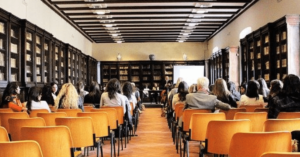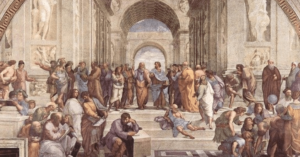Block 1: Communication Technologies: Basic
Unit 1: Introduction to ICT
Briefly explain the process of communication. Means and functions of communications
Write a note on problem – based learning (PBL).
Discuss framework suggested by A.W. Bates for deciding the use of technology in open learning.
Briefly examine the emerging trends, with the help of powerful Information and Communication Technologies (ICTs) for engaging in teaching-learning.
Write a note on major steps involved in developing e-learning environment.
What are the four steps involved in planning and organizing audio programs before recording ?
List the characteristic of Learning Objects (LO).
Explain the concept of m-learning and examine the major strengths and limitations of m – learning.
“Internet facilitates real time communication through number of conferencing tools”.
Elaborate the statement with the help of various forms of conferencing.
Discuss the process involved in script – development phase of interactive multimedia.
What are the advantages of computer networks ? Explain the different types of topology.
Discuss Instructional Design for e-learning.
What is sound ? Discuss the components of audio.
Write a note on Analog vs. Digital.
Explain the educational uses of Discussion Groups.
Write a brief note on Wiki.
What are the advantages of learning objects ?
Discuss the strengths and limitations of LMS.
Write a brief note on e-mail.
What are the processes to be considered while designing teleconference sessions ?
Describe the media and technology used in M-Learning.
Discuss the role of Intellectual Property Rights in Distance Learning.
Describe the pedagogical design in e-learning.
Explain different types of teleconferencing and discuss their advantages and limitations.
What is concept mapping ? Discuss the tools used for concept mapping.
Explain the process of video production.
What are the advantages of RSS used in education ?
How to use blogging in learning ?
Explain the characteristics of learning objects.
Describe the features of LMS.
Write a brief note on mailing list.
Discuss the Indian experiments used in satellite based education.
Describe assessment and evaluation in technology-enabled learning.
Explain various file formats of audio and video components.
Express your views on the statement “Pedagogical design as a create process”.
Discuss any two pedagogical designs suitable for distance education.
Explain the process of teleconferencing session. Write any two advantages of teleconferencing.
What are the factors to be considered to evaluate educational websites ? Explain.
Write a short note on e-portfolio.
Discuss briefly about ‘Video on Web’. Give examples.
Explain the main features of instant messengers.
Write a short note on virtual laboratories.
Discuss how blogging can be used in teaching and learning.
Explain ‘Pod Costing’ and its uses in ODL.
List out the characteristics of interactive multimedia. Explain with examples.
Describe functions of social networking in education with examples.
Write the role of Radio in distance education. Explain emerging trends in Radio.
Discuss ‘Communication in Distance Education’. List any three major shortcomings of ‘non-print medium’.
Explain how technologies can be used in assessment with examples.
What are the three levels of evaluation in interactive multimedia ? Explain.
Write short note on copyright in the digital world.
What is ‘Web Casting’ ? Explain with examples.
List out the use of graphics in printed learning materials.
Give three uses of simulation in education.
Describe the main features of web conferencing.
What is SCORM ? Write any two advantages of it.
Describe the process of video production.
What are roles of Wikis in education ?
List out strengths and limitations of Wilds.
Describe the development of community radio and low cost radio FM stations for distance education.
Explain types of Computer networking with examples.
Discuss the process of ‘Change’ and the concept of ‘diffusion of innovation.
Explain teleconferencing. What are the processes involved for designing a teleconferencing sessions.
Describe Sharable Content Object Reference Model (SCORM).
Distinguish between Learning Management System (LMS) and Learning Content Management System (LCMS).
Explain media and technologies in designing e-learning ?
Write short note on Scenario – based learning.
Describe digital games in educational system.
What are the Weaknesses of the television as an educational medium ?
Describe the principles of graphic design. What are the advantages for using concept map tools in teaching learning process.
Identify different types of digital audio formats and describe the advantages of digital audio in distance education.
List the strengths and limitations of various web 2.0 tools and explain the uses of web 2.0 tools for teaching and learning.
Explain the concept of network ? List some major advantages of computer networking.
Discuss management of intellectual property and copyright within a technology-enabled learning environment.
Explain some national and international experiments in the use of Satellites in education.
Explain the features of LMS.
What are the factors need to be considered to evaluate an educational website ?
Describe different types of technologies used in designing m- learning.
Distinguish between internet and www.
Describe open source and open content in education system.
Write a short note on recording audio using Audacity.
List any three blogging services on the web.
What are the benefits of blogging for learning ?
Define learning objects. Describe critiques on learning objects.
Explain the principles of designing educational multimedia and evaluate interactive multimedia resources for learning.
Describe the barriers towards effective communication in distance education.
Examine the use of webcasting in the open and distance learning system.
List out communication tools used for e-learning and explain each tool with examples.
Explain learning by designing in the context of distance education.
Discuss advantages and limitations of teleconferencing.
Describe the typical characteristics of e-learning solutions.
Differentiate between Video Chatting and Web Conferencing.
What are the reusable learning objects in distance education ?
Explain different types of audio formats which are used for audio packages.
Explain the principles of designing educational multimedia and describe the advantages of multimedia.
Analyse the factors affecting management of technological changes in Open and Distance Learning (ODL).
Describe the principles of graphic design and explain different types of graphic formats.
Define interactive multimedia. Evaluate interactive multimedia resources used for distance learning.
Describe the use of teleconferencing in distance education. Explain the processes involved in teleconferencing.
Discuss instructional design for e-learning.
What is simulation ? How is it used in distance education ?
Describe the features of learning management system (LMS).
Expand and explain SCORM.
Critically examine the cost and technology issues in distance education.
Explain a ‘concept mapping’ tool. How is it useful for preparing a concept map ?
List the advantages of computer networking.
Explain the advantages and disadvantages of m-learning and give examples pertaining to use of m-learning in teaching and learning.
Discuss management of intellectual property and copy rights within a technology-enabled learning environment.
Critically analyze the teachers to be considered to evaluate educational websites. Explain.
Unit 1: Introduction to ICT
Communicate means ‘to share’. In education sharing means passing on knowledge, skills and attitudes. Education is a communication system between teachers and students. Education as a communication is an open system i.e. it has characteristics like negative entropy, feedback, steady state, differentiation, Equifinality, Teleology and Hierarchy.
Communication is a science. It is a scientific discipline to produce skilled communicators. It is an act of exchange between a receiver and sender. The matter of exchange could be ideas, thoughts, views, information and opinions. Means of exchange could be verbal or spoken words or written words, sound, gestures, postures, pictures, graphics, diagrams etc. To summarise, it involves three components – source, receiver and channel. Communication needs to purposeful and persuasive for a sender to achieve the desired outcome. Receiver should then be able to perform the required or intended action or function to achieve the common objectives of the communication. It is a complicated system as it involves the use of biological systems, cognitive systems, and socio-psychological systems. MacBridge defines some functions of communication system in a social system : Information, Socialisation, Motivation, Education and Entertainment. Means of communication or channel could be: Signs and sounds, Language, Postal System, Telephone, Mass Media, Satellite, Computers, Process of communication as per Shannon and Weaver, has five elements : sender, receiver, channel, coding system and noise. Sender Encodes Idea as a Message which passes through its Conceptual Filters (sender’s distinct skill, knowledge and personality factors) and is Transmitted through the Channel (route) over a Medium (message carrier) and which is finally (after the message moving through a Channel over a medium encountering noise) is received by the receiver (before that it passes through the receiver’s conceptual filters and then its decoded at its end eventually). If the receiver is effective i.e. it can remove noise and decode and listen, the message is delivered as the message is lost. This is communicated back as a feedback. Feedback is a message back to the sender from a receiver that the intended task is performed. Hence it is always a closed loop communication or two way communication and the use of feedback improves the communication process by reducing disparities between the intent of the communication and the action to be performed. Noise is a distraction that interferes with the message and its integrity or leads to wrong delivery (unintended receiver).
Types of communications: Interpersonal, Group, Oragnisational, Mass. It could be in print or non-print. Mass is better delivered through radio and television programs i.e. broadcasting messages. In case of mass communication, the audience is large and heterogenous, source is an institution or a group of people and some kind of mechanism is used to reproduce information (production studio, printing press, internet, radio receivers, television).
Types of communication barriers: barriers caused by senders and receivers and barriers caused by external factors.
Communication in distance education is self directed learning by arranging teaching learning environments. A distance teacher communicates through a communication media which includes self-learning, print material, face to face counselling, tutorials, assignments, audio-videos, telecast, broadcast, interactive radio, e-mail, teleconference, internet, storage, computer conferencing, mobile etc. Communication media are extensions of man. All modes of communication print or non-print are human extensions. In case of distance education, it is an extension of a teacher that facilitates communication between them and their students. Classification of media in education means :audio, video, verbal, visual non-projected – print, 2D, 3D, visual projected, audio-video projected, multi-media, new emerging media. . In short, audio, video, audio-visual, tactile. Bretz classified them into seven classes – audio-motion-visual, audio-still-visual, audi-semi-motion, motion-visual, still-visual, audio and print.
There is a technology that makes life easier for people with disabilities. Classification of disabilities fall under four classes – vision related, hearing related, mobility related and cognition related. Nevertheless, today, it is possible to provide equivalent learning resources in alternative formats to people with disabilities with the help of Assistive Technologies (AT). AT could be like screen readers, voice recognition softwares, speech synthesisers, braille embossers, refreshable braille displays, adaptive keyboards. In short ATs can be classified under visual impairment, hearing impairment, physical impairment and cognitive impairment.
Unit 2: Communication Networks
Describe the factors affecting growth of communication networks – Political, economic, cultural, technological (appropriateness, accessibility,handling, maintenance, software), educational.
Communication network technologies – satellites, computer networks, data communication cables, network topology, network type (LAN, MAN, WAN), Wireless Networks, Internet,
Discuss the advantages of Computer Networking – resource sharing, global database, powerful communication medium, information management, online information exchange, saving money
Unit 3: Pedagogical Designs of ICT
Describe various pedagogical designs and elaborate any two of them – classroom, distance education, online learning, anchored video instruction, collaborative learning, problem based learning, discovery learning, scenario based learning, case based learning, learning by designing, self learning,
Unit 4: Managing Technological Change
Management of technology – decision making for use of technology, calculating costs of technology
Understanding management of change – need for change, nature of organisations, importance of leadership, vision and strategic planning, factors acting management of technological change
Innovation as change and diffusion of innovation
Managing IP – Copyright, Open Source, Open Content
Unit 5: Student Assessment in Technology Enhanced Learning and Evaluation of Technology
Analyse various technologies available for people with disabilities.
Assessment and evaluation – technology in assessment, evaluation of technology
Media and Learning – role of media in learning, optimising the influence of media in learning, review of non significant difference phenomenon
Evaluation of technology in education – a framework.
Technology in assessment – computer assisted assessment, online assessment, ePortfolio , Making assessment authentic.
Block 2: Technology Primer
Unit 1: Radio and Audio
Discuss the strengths and limitations of radio and audio media in education.
Explain different types of digital audio formats – talk, panel discussion, interview, drama, documentaries, magazine, talk show, quiz, reports.
Analyse the development of community radio and low cost FM Radio.
Unit 2: Television and Video
Discuss the advantages and disadvantages of television broadcasts and video cassettes in education.
Compare video and TV broadcasts
Unit 3: Satellite Based Education
Write briefly the characteristics of satellites.
Differentiate the satellite communication to that of terrestrial communication.
Critically examine the Indian Experiments in use of satellite in education
Unit 4: E-Learning
Discuss briefly the issues involved in building e-learning environments.
Web Based Learning, Virtual Learning, Online Learning, E-E-learning
Advantages – course material (quick production, alteration), interaction (student, tutor, course writers for enriched learning), Location (Place and Time Independent), Scale, Platform, Personalisation, Integration
Disadvantages – Accessibility, Bandwidth, Cost, Training, Standard, IP, Authentication (security and identity)
Unit 5: M-Learning
Explain the concept of m-learning and analyse the strengths and limitations of m-learning.
Block 3: Content Creation Tools
Unit 1: Communicating with Graphics
Unit 2: Digital Audio
Different Audio formats?
What are formats for education based on digital audio?
Unit 3: Digital Video
Examine the various stages involved in the process of video production.
Unit 4: Interactive Multimedia
Classify communication media according to different authors and briefly elaborate about the non-print media.
Explain briefly the characteristics of interactive multimedia and discuss the steps involved in script-development for inter active multimedia.
Write a critical note on social networking.
Discuss briefly the approaches used for evaluation of interactive multimedia.
Discussion Groups? Educational Uses of DG?
Strengths and Weakness of Wikis
Colour Theory?
Classify media based on interactivity.
Advantage of collaborative learning
Unit 5: Creating Materials for the Web
Discuss tools for creation of web-pages and briefly elaborate any two of them.
Process of integrating media and scripts into web pages
Block 4: Interactive Delivery Methods
Factors affecting management of technological change
Unit 1: Email, Mailing Lists, Discussion Groups, RSS Feed
Write a brief note on Electronic Mail.
Unit 2: Web 1, 2, and 3
Analyse the difference between web 1.0 and web 2.0.
Strengths of Wbe 2.0?
Unit 3: Virtual Classroom and Virtual Reality
You have to organise a teleconference session for your course. Explain the stages you will follow to organise the teleconference.
Pedagogical design in classroom and distance learning process
Unit 4: Reusable Learning Objects
Describe briefly the characteristics and advantages of learning objects.
Write a brief note on open source, open content.
Learning Outcomes
Reusable Learning Objects – Characteristics , Advantages and Critique
LTSC, IEEE:LO is any entity (Digital and/or Non-Digital), used (re-used, referenced) during technology supported learning. Like Computer Based Training System (CBTS), Interactive Learning Environments (ILE), Intelligence Computer Aided Instruction System (ICIS), Distance Learning Systems (DLS) and Collaborative Learning (CL) environments.
Reusable Information objects – concept, fact, principle, process and procedure. Learning object is based on performance objective. It contains objective (intended result or outcomes of a learning activity), content (static or interactive) and activity or practice (how to teach) and assessment (measure if the objective or outcomes have been delivered). Everything in LO is identified (for search and retrieval) with meta data. LOs are structured in a meaningful way tied to educational objective. Without this connect with the educational objective, learning objectives are mere collection (or content). LO can be customised, reused and searched and retrieved. LOs are assembled in a database. They are then delivered and assembled or grouped into lessons, modules, courses, programs, role play, exercise, case study , labs etc. Technically LO has a content (along with the instructions or practice or activity and assessment) , meta data and interface (navigational controls using which the learner interacts with the LO).
Characteristics – Usability, Adaptability, Reusability, Context Neutrality, Interactivity, Traceability, Independent, Interoperability.
Learning Objects – Financial, Flexibility, Customisation, Future Proofing, Time Saving, High Quality Resources, Access, Ease of Production, Just In Time Learning, Learning Style
Benefits of LO – For Authors, For Learners
Learning Objects – meta data standards and specifications – AICC, Dublin Core, IMS, LTSC, SCORM, ARIADNE
Shareable Content Object Reference Model (SCORM). It is not a standard. It is detailed implementation reference for interoperability of systems, content and technologies. It is being developed and refined by Advanced Distributed Learning (ADL).
Structure and components of learning outcomes
Learning Object Creation process
Unit 5: Learning Management Systems
Discuss the steps to be considered while deciding on the use of LMS for an instruction and the criteria to be kept in view for selecting LMS.
LMS –
features- learner tool (communication, engagement, productivity), Support tool (administration, course delivery, content delivery)
advantages (central, 24×7, simple, tracking, saves time, collaborative, one stop shop) and
disadvantages (template vs knowledge development, tracking vs safe environment, education vs technology focus of learning)
LCMS vs LMS
Criteria for selecting LMS – TCO, Maintenance, Usability, Vendor Profile, Openness, Standards, Integration, LOMI, Reliability, Scalability, Security, Hardware and Software, Multilingual,
TCO of LMS
LMS Examples – Moodle, ATutor, Other LMS
Block 5: Learning Portfolio




